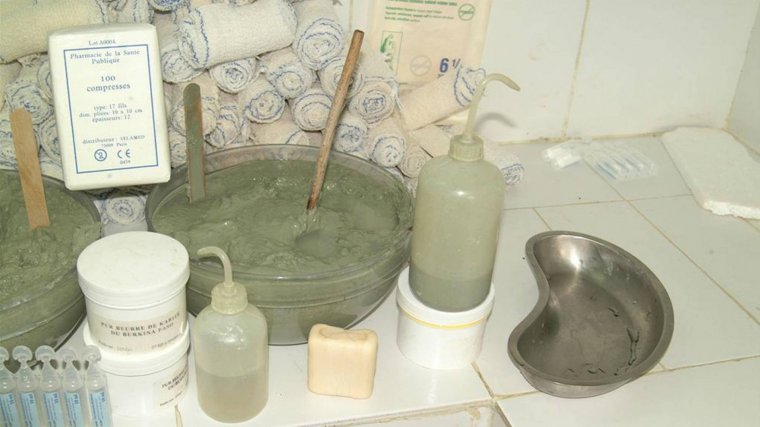| Health / Health News |
New answer to MRSA, other 'superbug' infections: clay minerals?
NSF | AUGUST 16, 2014
Superbugs are pathogens, or disease-causing microorganisms, resistant to multiple antibiotics. Such antibiotic resistance is now a major public health concern. Could the answer to this threat be hidden in clays formed in minerals deep in the Earth?

French green clays are used for healing Buruli ulcers. Credit: Thierry Brunet de Courssou
Biomedicine meets geochemistry
"As antibiotic-resistant bacterial strains emerge and pose increasing health risks," says Lynda Williams, a biogeochemist at Arizona State University (ASU), "new antibacterial agents are urgently needed." To find answers, Williams and colleague Keith Morrison of ASU set out to identify naturally-occurring antibacterial clays effective at killing antibiotic-resistant bacteria.
The scientists headed to the field--the rock field. In a volcanic deposit near Crater Lake, Oregon, they hit pay dirt.
Back in the lab, the researchers incubated the pathogens Escherichia coli and Staphylococcus epidermidis, which breeds skin infections, with clays from different zones of the Oregon deposit.
They found that the clays' rapid uptake of iron impaired bacterial metabolism. Cells were flooded with excess iron, which overwhelmed iron storage proteins and killed the bacteria.
The ability of antibacterial clays to buffer pH also appears key to their healing potential and viability as alternatives to conventional antibiotics.
Yet there is often no understanding of the reaction between the minerals and the human body or agents that cause illness. This research explains the mechanism by which clay minerals interfere with the functioning of pathogenic bacteria. The results have the potential to lead to the wide use of clays in the pharmaceutical industry.
Ancient remedies new again
Clay minerals have been sought for medicinal purposes for millennia. Studies of French clays--green clays historically used in France in mineral baths--show that the clays have antibacterial properties. French green clays have been used to treat Mycobacterium ulcerans, the pathogen that causes Buruli ulcers.
Common in Africa, Buruli ulcers start as painful skin swellings. Then infection leads to the destruction of skin and large, open ulcers on arms or legs.
Delayed treatment--or treatment that doesn't work--may cause irreversible deformities, restriction of joint movement, widespread skin lesions, and sometimes life-threatening secondary infections. Treatment with daily applications of green clay poultices healed the infections. These clays demonstrated a unique ability to kill bacteria while promoting skin cell growth.
Unfortunately, the original French green clays were depleted. Later testing of newer samples didn't show the same results. Research on French green clays, however, spurred testing of other clays with likely antibacterial properties. To date, the most effective antibacterial clays are those from the Oregon deposit.
Samples from an area mined by Oregon Mineral Technologies (OMT) proved active against a broad spectrum of bacteria, including methicillin-resistant S. aureus (MRSA) and extended-spectrum beta-lactamase-resistant E. coli (ESBL).
What's in those rocks?
Understanding the geologic environment that produces antibacterial minerals is important for identifying other promising locations, and for evaluating specific deposits with bactericidal activity.
The OMT deposit was formed near volcanoes active over tens to hundreds of thousands of years. The Crater Lake region is blanketed with ash deposits from such volcanoes.
OMT clays may be 20 to 30 million years old. They were "born" eons before deposits from volcanoes such as Mt. Mazama, which erupted 7,700 years ago to form the Crater Lake caldera. Volcanic eruptions over the past 70,000 or so years produced silica-rich magmas and hydrothermal waters that may have contributed to the Oregon deposit's antibacterial properties.
To find out, Williams and Morrison took samples from the main OMT open pit. Four types of rocks were collected: two blue clays, and one white and one red "alteration zone" rock from the upper part of the deposit.
Blue clay to the rescue
The OMT blue samples were strongly bactericidal against E. coli and S. epidermidis. The OMT white sample reduced the population of E. coli and S. epidermidis by 56 percent and 29 percent, respectively, but the red sample didn't show an antibacterial effect.
Chronic, non-healing wounds, are usually more alkaline (vs. acidic) than healthy skin. The pH of normal skin is slightly acidic, which keeps numbers of bacteria low.
Antibacterial clays can buffer wounds to a low [more acidic] pH, like other accepted chronic wound treatments, such as acidified nitrate. The clays may shift the wound environment to a pH range that favors healing, while killing invading bacteria.
The Oregon clays could lead to the discovery of new antibacterial mechanisms, she says, "which would benefit the health care industry and people in developing nations. A low-cost topical antibacterial agent is quickly needed."
Answers to Buruli ulcers, MRSA and other antibiotic-resistant infections may lie not in a high-tech lab, but in ancient rocks forged in a hot zone: Oregon's once--and perhaps future--volcanoes.
YOU MAY ALSO LIKE


